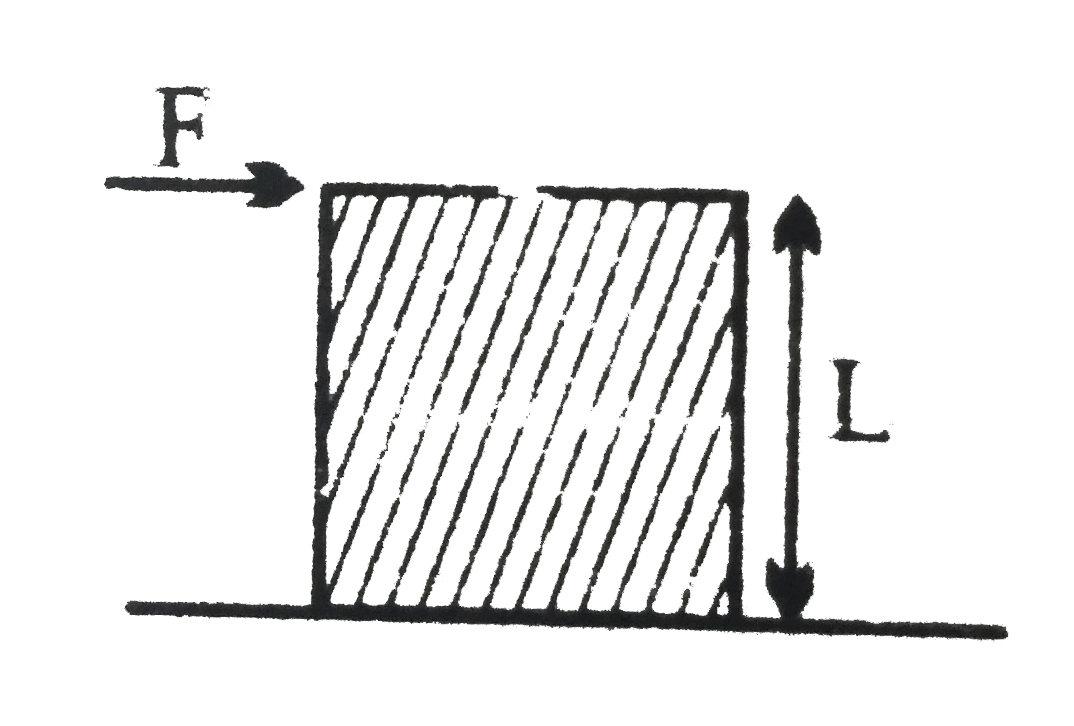A 30kg block rests on a rough horizontal surface A force of 200N is applied on the block The block acquires a speed of 4m/s starting from rest in 2s What is the value of coefficient of friction ? .
√3/10
10/3
0.47
0.185
The correct Answer is:c
To find the coefficient of friction for the given problem, we can follow these steps:
Step 1: Identify the given data
- Mass of the block (m) = 30 kg
- Force applied (F) = 200 N
- Final velocity (v) = 4 m/s
- Initial velocity (u) = 0 m/s (starting from rest)
- Time (t) = 2 s
Step 2: Calculate the acceleration of the block
Using the equation of motion:
v=u+at
Substituting the known values:
4=0+a⋅2
a=42=2m/s2
Step 3: Apply Newton's second law
According to Newton's second law:
Fnet=m⋅a
The net force acting on the block can be expressed as the applied force minus the frictional force:
Fnet=F−Ffriction
Thus, we can write:
F−Ffriction=m⋅a
Substituting the known values:
200−Ffriction=30⋅2
200−Ffriction=60
Step 4: Solve for the frictional force
Rearranging the equation gives:
Ffriction=200−60=140N
Step 5: Relate frictional force to the coefficient of friction
The frictional force can also be expressed as:
Ffriction=μ⋅N
Where N is the normal force. For a horizontal surface:
N=m⋅g=30⋅10=300N
Now substituting into the friction equation:
140=μ⋅300
Step 6: Solve for the coefficient of friction
Rearranging gives:
μ=140300
μ=0.4667
Step 7: Round to two decimal places
Thus, the coefficient of friction μ is approximately:
μ≈0.47
Final Answer:
The coefficient of friction is μ≈0.47.
---
- Mass of the block (m) = 30 kg
- Force applied (F) = 200 N
- Final velocity (v) = 4 m/s
- Initial velocity (u) = 0 m/s (starting from rest)
- Time (t) = 2 s
Using the equation of motion:
v=u+at
Substituting the known values:
4=0+a⋅2
a=42=2m/s2
According to Newton's second law:
Fnet=m⋅a
The net force acting on the block can be expressed as the applied force minus the frictional force:
Fnet=F−Ffriction
Thus, we can write:
F−Ffriction=m⋅a
Substituting the known values:
200−Ffriction=30⋅2
200−Ffriction=60
Rearranging the equation gives:
Ffriction=200−60=140N
The frictional force can also be expressed as:
Ffriction=μ⋅N
Where N is the normal force. For a horizontal surface:
N=m⋅g=30⋅10=300N
Now substituting into the friction equation:
140=μ⋅300
Rearranging gives:
μ=140300
μ=0.4667
Thus, the coefficient of friction μ is approximately:
μ≈0.47
The coefficient of friction is μ≈0.47.
Topper's Solved these Questions
- LAWS OF MOTIONBOOK - PRADEEPCHAPTER - LAWS OF MOTIONEXERCISE - Integer Type Questions
7 Videos
- LAWS OF MOTIONBOOK - PRADEEPCHAPTER - LAWS OF MOTIONEXERCISE - Assertion- Reason Type Questions
17 Videos
- LAWS OF MOTIONBOOK - PRADEEPCHAPTER - LAWS OF MOTIONEXERCISE - Problems for practice
112 Videos
- KINEMATICSBOOK - PRADEEPCHAPTER - KINEMATICSEXERCISE - 1 NCERT Comprehension
4 Videos
- MATHEMATICAL TOOLSBOOK - PRADEEPCHAPTER - MATHEMATICAL TOOLSEXERCISE - Fill in the blanks
5 Videos
Similar Questions
A block of mass 10 kg is placed on the rough horizontal surface. A pulling force F is acting on the block which makes an angle θ above the horizontal. If coefficient of friction between block and surface is 43 then minimum value of force required to just move the block is (g=10ms2)
View SolutionA 10kg block is initially at rest on a rough horizontal surface. A horizontal force of 60N is required to set the block in motion . After it is in motion , a horizontal force of 50N is required to keep the block moving with constant velocity . The ratio coefficient of static and kinetic friction is
View Solution
Knowledge Check
A block of mass 20 kg is placed on a rough horizontal surface. When a force of 80 N is applied at an angle of 30°with the horizontal, the block just begins to slide. What is the coefficient of static friction ? (g=10m/s2)
A0.253B0.433C0.63D0.75A block of mass 3kg is placed on a rough horizontal surface (μs=0.4) . A force of 8.7N is applied on the block. The force of friction between the block and floor is .
A8.7NB12NC10NDzeroA block of mass 2 kg rests on a horizontal surface. If a horizontal force of 5 N is applied on the block, the frictional force on it is (take,uk=0.4,μs=0.5)
A5NB10NC8NDzero
A 20 kg block is initially at rest on a rough horizontal surface. A horizontal force of 75 N is required to set the block in motion. After it is in motion, a horizontal force of 60 N is required to keep the block moving with constant speed. The coefficient of static friction is
View SolutionA block A of mass 2 kg rests on a horizontal surface. Another block B of mass 1 kg moving at a speed of m/s when at a distance of 16 cm from A. collides elastically with A. The coefficeint of friction between the horizontal surface and earth of the blocks is 0.2. Then (g=10m/s2)
View SolutionA cubical block of side L rests on a rough horizontal surface with coefficient of friction μ. A horizontal force F is applied on the block as shown. If the coefficient of frictions sufficienty high so that the block does not slide before toppling, the minimum force required to topple the block is :
 .
.
View SolutionA cubical block of side L rests on a rough horizonta surface with coefficient of friction μ. A horizontal force F is applied on the block as shown. If the coefficient of friction is sufficiently high so that the block does not slide before toppling, the minimum force required to topple the block is

View SolutionA block of mass m is placed on a rough horizontal surface. If minimum force to pull the block is mg2 then coefficient of friction is :
View Solution
